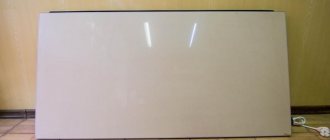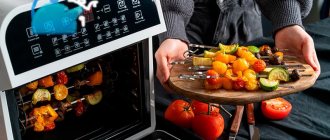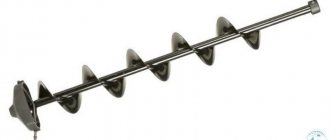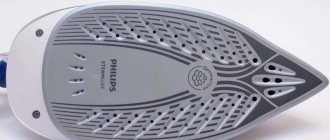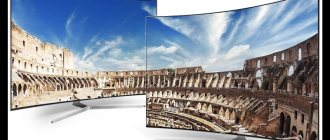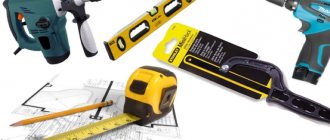In apartments and private houses, designers often use zoning. The living room and kitchen combine well. Two rooms connected to each other look spacious, and this layout will make the space cozy.
You can update the design, implement interesting ideas, or repeat a design seen in a magazine, TV show, or photo on the Internet. The style in the living room-kitchen can be different, and choosing it can turn into a fun experience.
Before combining rooms, designers advise taking into account the basic rules, creating a project, and choosing colors.
Zoning
Designers do not advise giving in to fashion trends and copying design ideas without taking into account dimensions, location and other nuances. Before planning and arranging furniture, every detail is thought through.
There are several simple rules that experts advise you to follow:
- Let the room have natural light. To do this, remove excess walls (except for load-bearing ones).
- If the rooms in the apartment are small (12 sq. m or 16 sq. m), the layout of the kitchen combined with the dining room will be the right solution.
- If the ventilation system is not designed correctly, the smell of food will spread throughout the apartment.
Pros and cons of aluminum radiators
Over the past half century, nothing has changed with regard to aluminum radiators - they are also actively used to equip heating systems of public institutions and multi-apartment residential buildings. Neat, lightweight and easy to install, the devices are also readily purchased for the improvement of private homes.
Aluminum radiators have several undoubted advantages, and often they “outweigh” the disadvantages (which also exist) and are the decisive arguments in the choice.
Image gallery
Photo from
Aluminum has excellent heat transfer parameters
Lightweight overall structure
Possibility of installing a thermostat for adjustment
Variety of shapes and sizes of radiators
According to user reviews, aluminum devices harmoniously complement the interior of rooms, and if they stand out from the overall picture with their industrial design, they are easily disguised with a decorative screen or box with holes.
But batteries made of relatively soft metal also have their weaknesses, including:
- A characteristic feature of aluminum is to enter into chemical reactions with the coolant, resulting in the formation of corrosion and gases;
- Air vent valves prevent air locks from occurring;
- low resistance to high pressure and water hammer, typical of central highways;
- sensitivity to incorrect installation - installation errors can disrupt the uniform distribution of coolant throughout all sections.
Due to the listed technical characteristics, experienced installers do not recommend equipping circuits dependent on the central line with aluminum heating radiators.
The system operates in such a way that water hammer and sudden changes in pressure are not excluded. Due to instability, the most unprotected places - joints and connections - can fail.
Aluminum reacts sensitively to stray currents, which are one of the causes of corrosion. Too acidic or alkaline coolant also causes emergency destruction of the material, resulting in the replacement of the device
Due to the listed disadvantages, it is better to connect aluminum devices to a more stable cottage heating system. It is protected not only from water hammer, but also from low-quality coolant. If you still choose an aluminum battery for a high-rise building with main heating, it is better to prefer anodized models.
Partitions
The interior of the kitchen and living room begins to be thought out from the junction of the two zones.
- Here are some of the ways and objects that delimit space:
- installation of a bar counter;
- kitchen island;
- big table;
- installation of a low partition.
Designers advise installing a wide counter, since you can sit at it like at a regular table, and high chairs are quite suitable for the whole family.
However, in small rooms (16 sq m), narrow counters are installed. Kitchen islands are convenient to use, but are only suitable for large kitchen-dining rooms (25 sq m or 30 sq m). Capital low partitions are installed only if it has been decided in advance what they will be used for (for example, as a TV stand).
Abstract figures
If the great Salvador Dali could draw a clock sliding off a table, then why can’t a designer give a radiator the shape of a caterpillar divided into sections, or a rectangle consisting of cells? In these images, everyone will see something of their own, abstract or quite concrete.
Photo: decoist.com
Finishing
If the kitchen combined with the living room has the same floor covering, then there are no special rules for carrying out the work. When combining different materials, take into account in advance where they will be joined.
For example, laminate flooring creates unsightly joints with tiles. The main thing is that the floor is flat without curved joints, as they will be noticeable.
Kitchen cabinets that are mounted on the walls should reach the ceilings. In some cases, craftsmen “lower” the ceiling with plasterboard.
Materials for decorative batteries
Cast iron designer radiator
Interior heat exchangers are made from different materials, with the help of which any wishes of the customer are realized. Raw materials used for production: metal, glass, stone, wood.
Cast iron
Designer cast iron radiators are expensive products, as they are most often made in a vintage style. When creating a three-dimensional design, labor-intensive techniques for working with metal are used.
Heating products made of cast iron are durable and heavy. The latter characteristic complicates the installation process, since you have to work with a lot of weight. Cast iron also has a high heat capacity.
Bimetallic
Bimetallic radiator
Combined versions of the units have laconic shapes to create a modern room style. Bimetallic heat exchangers are made in the form of steel, copper, aluminum panels or sections. These materials are not susceptible to corrosion processes. Bimetal is also able to withstand high pressure loads, which allows you to heat rooms efficiently and quickly.
Steel
Steel is a durable material, so designer radiators made from this metal are practical and at the same time aesthetically pleasing interior items. They have the form of tubular and panel products. Heating steel systems almost do not oxidize, do not deform under mechanical and other influences, and are relatively light in weight, which simplifies installation.
Glass
Glass batteries
For consumers with refined taste, unusual heating elements made of glass will suit them. They consist of two plates, of which the lower one is a durable panel, since it receives heat, and the upper one has a decorative function.
Stone
Stone radiators are environmentally friendly heating options. Batteries have an advantage over other analogues - slow heat transfer. Thanks to this characteristic, the rooms are heated more thoroughly. Also, stone radiators do not create noise during operation and do not dry out the air. The downside is the high price.
Furniture items
A few examples of furnishing a kitchen combined with a living room:
- 1. Sofa. It becomes an object that zones space. The sofa is placed with its back facing the place where food is prepared. In small rooms (less than 20 sq m) a corner is placed, which is placed against a wall installed perpendicular or parallel to the kitchen.
- 2. Set. According to designers, minimalist models without elaborate details look modern. The service, vases or glasses are placed on an open shelf. You can buy a fashionable display case for them. Furniture is placed near the wall. If the space is large (20 sq. m, 25 sq. m or 30 sq. m), then in the central part you can install an island, which also has sections for kitchen appliances.
- 3. Furniture set. The style should be combined with the design of both rooms. In small rooms, a compact table and chairs made of transparent material or painted in light colors look good. You can add a table with a round top to your living room interior. In spacious rooms, the kit is installed near the wall or in the central part. An elongated rectangular dining table would look good here.
Classification of batteries by manufacturing technology
For the production of heating radiators, it is not aluminum in its pure form that is used, but its alloys with silicon. Separate sections and whole products are obtained from blanks. The main methods of metal processing are extrusion and casting.
Type #1 – extrusion
On production lines, the main tool for the manufacture of extrusion devices is a molding extruder, which literally extrudes the required profile onto metal blanks.
The disadvantage of the technology is the production of separate parts, which are subsequently connected by pressing. Of course, the seams on the structure make it vulnerable to pressure changes and unclean coolant.
Sections and manifolds are made using extrusion. After the parts undergo pressing processing, it is not possible to change their size, therefore, during installation, the length of the finished products cannot be changed
Extrusion models are the most inexpensive among aluminum ones. They are characterized by a smaller working surface area, which reduces the heat transfer of devices. The seams obtained as a result of pressing are gradually destroyed by contact with low-quality coolant.
The corrosion process is also more active because secondary aluminum is used as a raw material for extrusion, a characteristic feature of which is the presence of rapidly oxidizing impurities.
Type #2 – cast
Radiators produced by casting technology have higher performance indicators. They are safer, stronger and more resistant to aggressive environments than their extrusion counterparts, and therefore more expensive. For manufacturing, aluminum (from 88%) and alloys with the introduction of silicon (up to 12%) are used.
Production occurs as follows. The molten metal enters the casting molds, where it acquires a given profile. The parts that have received the design configuration are cooled, processed and checked for leaks. The walls of the workpieces are treated on all sides with an anti-corrosion compound.
After further cooling and drying, the almost finished sections are painted with protective polymer enamel with the addition of epoxy resins. Final stage – assembly and testing
Various manufacturers are experimenting with casting technology, resulting in new types of radiators. Let's say the Faral Trio company has released a line of two-channel radiators that have not lost strength and cope well with burst pressure of more than 55 atm.
And Italian Raden radiators have vertical fins of 6 rows, due to which there is an increase in heat transfer.
If you want your heating system to be equipped with truly reliable and protected devices, pay attention to anodized batteries. These are radiators made of aluminum coated with a durable oxide film, which has two purposes - protection and decoration.
The oxidation process several times increases the metal’s resistance to corrosion and other negative changes or reactions to the poor quality of the liquid circulating through the channels of the devices.
Multi-level floor
To zone the space, craftsmen install floors at different levels. They advise installing a podium to separate the kitchen and dining room. This option is considered one of the most practical because, among other things, the owners have additional free space where they can hide something.
It is convenient to use boxes or crates for this. Wicker baskets will look good. But such space can remain free.
For podiums, reliable materials are selected that can withstand heavy loads. Usually builders make wooden or metal podiums.
However, such a design should not be made if there are small children in the family, since the podium can become an obstacle for him. In addition, various floor coverings can be used.
They will zone the space between the living room and the kitchen and protect the podium from damage. For example, tiles are laid in the kitchen area, and laminate flooring in the dining room. The main thing is to choose colors and textures and combine the finishes correctly.
Coolant for aluminum radiators
Antifreeze has different properties depending on the content of various impurities in it Source probaltur.ru
Everyone knows that water is the cheapest coolant for heating systems of multi-storey and private houses, but aluminum radiators do not agree with this. Practice is the best teacher and it has shown that when using drinking or even process water, oxides, scale and some other strange sludge appear in the heating circuit (pipes, radiators). So such a system will have to be periodically flushed so that the deposits do not acquire the state of stone, when ordinary flushing will no longer help. This suggests that you need some kind of special coolant that is friendly with aluminum and can be bought in the store.
Important! When installing a heating system with aluminum radiators, under no circumstances should you use copper and brass taps and fittings. In this case, polypropylene pipes and fittings are best suited for the pipeline, all connections and shut-off valves.
For normal operation of the heating system, you need to choose the right antifreeze Source probaltur.ru
To stabilize the operation of autonomous heating systems, various antifreezes are used, but, as you understand, this is not always safe, so special attention should be paid to the reliability of the circuit (all soldered and threaded connections). Such liquids are usually not drained during the warm season - there is simply no need for this. Don’t forget that not all systems can be filled with such a coolant (we’ll talk about the limitations below).
Make your choice:
- Glycerin composition. As a substance, such a composition is completely harmless, which means it is not dangerous when cold. When working with glycerin coolant, there are practically no oxides or various sludge. The mixture is designed for long-term use.
- Ethylene glycol composition. This mixture is dangerous for humans, so when filling the system you must use a respirator, rubber gloves and safety glasses. The presence of such a substance in the coolant must be indicated by the manufacturer.
- Propylene glycol composition. Unlike ethylene, propylene is harmless to humans, but has a higher cost, which often stops buyers. For a heating circuit, such a coolant can be called one of the best.
SOLAOTERM-EKO is the most acceptable solution for preserving batteries for a long time Source elektroservis-rostov.ru
Styles
There are many current trends and design ideas. The kitchen-living room in a modern style looks simple and minimalistic.
At the same time, it is not necessary to strictly adhere to any style; you can take its main idea as a basis and cleverly play with it with accessories and other details.
Battery selection criteria
It is not difficult to purchase high-quality aluminum radiators; you just need to know certain features.
Experts recommend adhering to the following tips:
- You need to choose a proven, well-known brand. This serves as a kind of guarantee that the radiators will last a long time and without problems.
- Cost also plays a role. As a rule, if the equipment is really high-quality, then it definitely won’t be cheap.
- Aluminum batteries are not made in Germany, no matter what the seller claims. The fact is that panel steel appliances are installed in this country.
- When purchasing, you should study the product data sheet. It must necessarily indicate power characteristics taking into account the specific temperature of the coolant.
As you can see, there are not many criteria for a competent choice. In any case, you need to be careful with the characteristics so as not to make mistakes.
Is it worth buying Chinese-made products?
When choosing heating devices, you need to be attentive to their cost and quality. At the moment, there are many manufacturers of radiators, but most often their products are made in China. Of course, these products have an attractive price, but the quality may be inferior to European devices.
When purchasing devices from China, you need to pay attention to the following nuances:
- Battery weight. Often, in order to reduce the cost of products, manufacturers use less metal than necessary. This significantly reduces the cost of the product, but at the same time its quality decreases. When purchasing, make sure that the back wall of the batteries and the side ribs are thick enough. If the thickness is small, then the radiator will have a lower power rating, and pressure surges can completely rupture such a device.
- To reduce cost, the diameter of the vertical collector is reduced. Because of this, more plaque will begin to be deposited on the internal surfaces of the batteries, which will interfere with the free passage of the coolant. After 5 years of operation, the hole may become completely overgrown, that is, such batteries will no longer perform their task. Therefore, the diameter of the collector, which is indicated in the passport of a specific model, is so important.
Of course, you can use Chinese radiators, but not for as long as you would like.
Scandinavian
This style came into fashion several years ago, but still does not lose its relevance. Its practicality and European elegance are well suited for a living room in a city apartment or house. You can add bright accents, for example, textiles of different shades.
The basis for the Scandinavian style is white and gray finishing, wooden details. To decorate the space, pink, blue or ocher elements are suitable.
Types of modern radiators
Is it acceptable these days to use conservative solutions to complete heating systems (we are talking about cast iron radiators)? Of course, it is permissible, but it is much more practical to install aluminum and bimetallic batteries. Their disadvantages and advantages are known by comparison.
Cast iron radiators are a “classic of the genre.” These are quite massive products that heat up quickly and give off heat readily. Radiators with a cast iron body are very durable and well protected from corrosion, but their operation is troublesome. The outer surface of these products requires regular maintenance and touch-up, and the high inertia of cast iron can create problems when adjusting temperature conditions.
Cast iron radiators today are more of an integral design element than a high-tech solution. They can be found in lofts and rooms that are “tailored” to a certain style. From the point of view of widespread use, this is already a distant past.
Aluminum radiators are the most common type of radiators used in individual heating systems. These are lightweight, reliable and quite durable products. They effectively resist water hammer and are designed for high pressure (some models can withstand up to 20 atmospheres). Aluminum collectors are characterized by low inertia and high heat transfer coefficient. Additional advantages include relatively low cost. The disadvantages of aluminum radiators include poor resistance to corrosion, which can be caused by the properties of the coolant.
Bimetallic radiators, made of steel manifold pipes and an aluminum shell, give off heat a little less readily than products made of pure aluminum or aluminum alloys. But in terms of strength, they look much more advantageous than all the listed models. These products are somewhat more expensive than other types of radiators, but the costs of their purchase are fully offset by operational reliability, practicality and durability.
If the design of the heater contains steel and aluminum, this does not indicate the strength and reliability of the device. Sometimes only the vertical channels of the collector are steel. As a result, calling such a device a bimetallic radiator is a stretch.
A full-fledged bimetallic radiator has an all-steel manifold made of grade 20 carbon steel. This feature completely eliminates the interaction of the coolant with aluminum, prevents the formation of corrosion and guarantees high reliability of the device.
Hortek SPbUser FORUMHOUSE
How do you know if the radiator is bimetallic? To do this, just look inside. In practice, there are radiators that are called bimetallic, but the steel there is only in vertical channels (it is not visible from the outside). Such “bimetallic” ones are definitely not worth buying.
The experience of developers suggests: in domestic heating systems it is better to use either aluminum or bimetallic radiators. Which of them are more suitable for a particular case – let’s consider in more detail.
Loft
This year the style remains in demand. It is often used to equip kitchens combined with a living room. This combination gives more free space, which will only emphasize all the details of the loft.
Today, such a definition as “classic style” is used less and less by designers. Loft - any interior design in which various technical elements are not hidden, but emphasized.
For example, stylists play with brickwork, wires or concrete walls. The photographs clearly show how successful it can look like a living room that is combined with a kitchen.
For loft, rough and heterogeneous surfaces and rough materials are selected. In apartments decorated in this style, wall lamps are installed. In this case, the light is directed along the walls.
Due to this, shadows fall so that uneven surfaces look three-dimensional. At first, loft was viewed with caution, but it quickly became popular. Designers do not hide finishing materials and even fake them. To imitate a concrete surface and smudges, decorative plaster is used.
How to choose a radiator based on system pressure
The choice of radiators depends on the pressure in the heating system Source teplowood.ru
Regardless of which radiator you like best, or what its cost is, such devices must still correspond to the pressure in the system, and not only the nominal operating pressure, but also the test pressure ). If you live in an apartment in a multi-storey building and use centralized heating, then you most likely know that a thermal power plant or boiler house releases water under high pressure into the system at the beginning of the heating season. This is a necessary measure that allows you to identify weak points in the circuit (pipes, batteries). However, residents, as a rule, complain about leaks, not understanding what is happening (after all, there was no leak last year), but it is better to fix the problem at the beginning of the season than to do it in winter, draining water from the entire riser, and in severe frosts this It’s noticeable, and it’s worth the money.
| Heater material | Average pressure, bar | |
| Crimping | Working | |
| Cast iron | 15-18 | 9-12 |
| Steel | 10-13 | 6-8 |
| Bimetal | 30-35 | 20-25 |
| Aluminum | 9-15 | 6-8 |
Note to the table: 1 Bar is equal to 0.986923 atmospheres, therefore, when installing pipelines, Bars are most often used.
The upper table shows the average operating and test pressure values, but it may be slightly higher, so when choosing radiators you will have to take these numbers into account. But you will also have to take into account what kind of house you live in (meaning buildings connected to central heating). According to SNiP 41-01-2003, the pressure during pressure testing of the system should be 1.5 times higher than the working pressure, but we can overestimate this level. Therefore, compare the capabilities of the desired radiators with the table below.
| Number of floors | Average pressure, bar | |
| Working | Crimping | |
| Up to 5 | 2-4 | 3-6 |
| 9-10 | 5-7 | 7,5-10,5 |
| 11 and above | 12-14 | 18-21 |
| Skyscrapers | Set by the building designer | |
Important! If you want to know the exact test and operating pressure of your heating system, you need to contact the utility company that services your home directly.
Neoclassical
Even popular music has echoes of ancient motifs. The same can be said about the design, in which classic details are framed in a fashionable design.
This style is characterized by symmetrical lines, framed mirrors, arched openings, and antique accents. All this is complemented by fashionable finishing materials and accessories. Neoclassicism combines sleek modern details with traditional combinations.
Product packaging
To make the right choice of aluminum radiators, you need to monitor the product package.
Standard kit includes:
- left-hand and right-hand plugs;
- Mayevsky valve (is a valve for bleeding air from the heating system);
- brackets;
- racks;
- gaskets for sealing;
- Ball Valves.
The connection of aluminum radiators should only be carried out by specialists who have permission for such activities. It is strictly not recommended to do this work on your own. As for installing batteries, this must be done in accordance with the technical instructions supplied with the products.
Provence
The name of this destination comes from a region in the south of France. Even a small kitchen-living room, the decor of which was inspired by French aesthetics, will be filled with warmth and comfort.
The main thing is that it has a lot of daylight, textiles with romantic prints, and floral patterns. The dining room in the Provence style is designed in pastel shades. Furniture items can be vintage or artificially aged. Plain walls will contrast with large checkered curtains.
The door in the kitchen area set is sometimes replaced with curtains made from the same material as the tablecloth. A good addition would be vases and figurines, clay pots, forged metal parts and ribbons.
Installation recommendations
In order for the installed radiator to effectively perform its function, you must adhere to certain installation rules.
The way the batteries are located is also important:
- distance from the device to the wall - from 2 to 5 cm;
- distance from the floor to the device - from 10 to 12 cm;
- the distance from the top to the window sill is about 10 cm.
When installing equipment, shut-off and control equipment must be provided at the inlet and outlet. This will allow you to manually or automatically (if there are thermostatic valves) regulate the heating temperature. This is also done so that the batteries can be disconnected later, for example, if they need to be disassembled, washed or replaced with new ones. If necessary, if a leak appears, so as not to completely replace the equipment, it can be soldered.
In multi-storey buildings, heating devices are most often installed using a single-pipe system. But such a system does not provide temperature control devices.
When installing batteries, under no circumstances should they be hung on pipes. The device is mounted to the wall in such a way that the hooks of the brackets are located between the sections, and its lower part rests on the fasteners. To prevent future leaks, the connecting surfaces do not need to be cleaned.
While the device is being filled with coolant, the shut-off and control equipment must open smoothly, otherwise a water hammer may occur. Before installing radiators, each element of the system must be thoroughly washed. Do not use products that contain alkali.
For each aluminum radiator, an automatic device or manual valve should be provided to bleed air. During the work, you must adhere to the instructions that come with the device.
Color combinations
Stylists advise taking into account the following nuances:
- direction in the interior;
- combination of shades;
- illumination
It is much easier to choose a palette if the style for the kitchen and living room has already been selected. For example, neoclassicism and Provence have their own combinations. In a classic interior, designers combine pastel colors, pale colors, which are slightly diluted with dark shades.
In French country houses you can often see soft blue, pink, and pistachio colors. Art Deco designers make up objects and finishing materials in black and white, sometimes beige and brown or silver and black. The main thing is to choose a shade for the walls. White will become universal, it will expand the space, and later you can paint them with any paint.
However, in the cooking area, white ceases to look fresh. Beige or gray shades would be more practical. This background will highlight the other colors. In a monochrome interior, designers recommend gluing wallpaper in an unusual color or with a photo print.
Waterproof surfaces are easy to clean, so washable wallpaper is recommended. The colors of the furniture echo the details and accessories, be it cushions for the sofa, curtains or other items.
- Cast iron radiators
Radiator flushing
- Gas convectors
Specifications
Aluminum heating radiators have technical characteristics that allow complex heating of rooms, transferring one half of the heat by radiation from the battery panel, and the second by convection air flows.
One section of such radiators has the following indicators:
- depth – 70-110 millimeters;
- panel area – 0.5 m²;
- coolant capacity inside the battery – 0.4-0.6 liters;
- thermal power – 120 W;
- weight – maximum 2 kilograms;
- coolant temperature – 90 degrees.
The best known manufacturers and models: characteristics and prices
The most widely used brands are:
- Oasis . The Chinese concern was founded in 2006, so the factories are equipped with modern equipment, which guarantees quality. Some products are produced under licenses from Western European companies.
- Monlan , a Chinese company focusing on the market of the Russian Federation and some CIS countries. Economy class products are intended only for private homes, since the manufacturer saves on materials, the walls of the sections are thin and are not designed for high pressure. The reliability of work in private homes is not satisfactory. When purchasing, check the appearance - the color of the radiators may vary even in the same batch.
- Purmo , Finland, a recognized leader in the production of heating equipment.
- Tessen is one of the best Chinese manufacturers. The walls of the radiators are sufficiently thick; the technical characteristics of some models allow installation in apartment buildings.
- Global Radiatori , the concern's factories are located in European countries, cheap products are delivered from China.
- IPS , Italy. Produces radiators of the highest quality. Factories are located in Italy and Slovakia. The price of products is high, which limits the distribution of products.
- Rifar , Russia. The production is located in the Orenburg region. The manufacturer insures its products against destruction, but to obtain it, the installation of products must be carried out by a specialized organization.
- Royal Thermo , Russia. All products undergo quality control; aluminum radiators are necessarily processed using anodizing technology.
- Radena , Italy. All production is located in Italy, which gives additional confidence in quality. If other countries are indicated in the passport, this means counterfeit products.
- Mandarino , a Russian company operating under an Italian license. High quality is a distinctive feature of the products.
The most in demand are white radiators with a number of sections from 4 to 10 and with an interaxial distance of 350 or 500 mm - these are the products that are on display in construction supermarkets.
How to actually choose the cheapest heating radiators on the market
Below are the models that are leaders in sales and consumer ratings.
Royal Thermo Biliner Alum 500
The plant of the Russian company is located in the Vladimir region. The manufacturer draws attention to the unusual aerodynamic shape of the products, developed by the Italian company IPG Design Studio. Additional fins provide high performance. The center distance of the model is 500 mm. The gaskets are made of cotton with the addition of silicone and graphite, which allows them to withstand coolant temperatures up to 130 °C. Dimensions: 580x80x87 mm.
Painting occurs in 7 stages, which ensures the stability of the layer for the entire period of operation. The warranty for the model is 10 years. Royal Thermo Biliner Alum 500 is one of the best aluminum radiators for a private home and apartment.
Royal Thermo Revolution 500
Radiators of the series are presented only in white. The wave-like shape of the ribs ensures increased convection of air flows.
The paint is completely safe and is highly resistant, so the series radiators can be installed in bedrooms and children's rooms, as well as in wet areas. Dealers are located in dozens of cities.
STOUT BRAVO 500
A series of Italian radiators with a center distance of 500 mm and side connections, painted in RAL9010 and RAL9016 colors. The manufacturer notes the simple installation of the radiator and the availability of control valves, since the connecting dimensions are standard for similar products. The aluminum body provides low inertia - the sections quickly heat up when the boiler is turned on.
An important condition set by the manufacturer: the quality of the coolant must meet the requirements of SO-153-34.20.501-2003, which is difficult to achieve for houses connected to old heating systems. The warranty may not apply if it is proven that the requirements of the document have not been met.
Global VOX R 500
Radiators are produced by an Italian company founded in 1971. The model was developed taking into account Russian conditions (low water treatment of the coolant and pressure drops in the system).
Heat transfer measured at a difference in coolant and air temperatures of 50°C is 181 watts/section, and at a difference of 70°C - 276 W, which is the best indicator for devices of similar dimensions.
Rifar Alum 500
The line includes radiators of the same shape, but different in axial distance. Reliability is achieved by milling the end of the section for a specially designed gasket. The locking connection is patented by the manufacturer. Radiators with a number of sections from 4 to 14 are commercially produced.
The Alum series includes Ventil types for bottom connection. Rifar Alum Flex – radiators with a radius of curvature for installation along rounded walls.
Radena 500
The radiator was designed by Italian designers and has an oval channel section for coolant circulation, which increases the contact surface area and, accordingly, the heat transfer of the section, amounting to 195 W.
ROMMER Al Optima 500
The batteries are produced by a Russian brand at a Chinese factory. Quality is ensured by automatic production lines and careful output control of all product parameters. Model color is white.
Features of the model: wall thickness 1.8 mm, anti-corrosion treatment of internal surfaces, two-stage painting with a mandatory primer.
Among the disadvantages are the low heat transfer of one section - 133 W and the maximum coolant temperature of 110 °C.
Mandarino 500
The peculiarity of the product is that the series is assembled from square or round pipes without fins and has a one-piece design with anodic oxidation of surfaces. The products look unusual and elegant.
Radiator production technology
Manufacturing varies according to the type of raw materials used and technical features:
Connecting bimetallic heating radiators and installation costs
- Anodized aluminum radiators. The raw material is oxidized metal with a high silicon content. The devices resist corrosion and can withstand pressures of 50-70 bar.
- Cast instruments. They are manufactured in sections, the raw material is silumin (an alloy of aluminum and silicon). The production process takes place under high pressure, the shape of the sections can be different. The internal channels of the batteries are expanded for normal coolant circulation, the walls of the heat exchanger are thick enough for the device to withstand pressure of 6-16 bar.
- Extrusion batteries. They are made by pressing raw materials through molds, then the parts of the devices are fastened together. For the production of collectors, silumin is used, for other parts - an alloy with a lower silicon content.
On a note! Extrusion batteries are inexpensive, but the model cannot be expanded or improved during operation.

